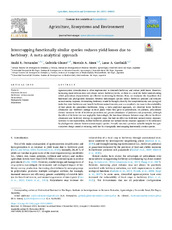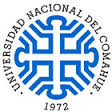JavaScript is disabled for your browser. Some features of this site may not work without it.
Mostrar el registro sencillo del ítem
| dc.creator | Fernandez, Anahí R. | |
| dc.creator | Gleiser, Gabriela | |
| dc.creator | Aizen, Marcelo A. | |
| dc.creator | Garibaldi, Lucas A. | |
| dc.date | 2023 | |
| dc.date.accessioned | 2023-12-14T13:43:10Z | |
| dc.date.available | 2023-12-14T13:43:10Z | |
| dc.identifier.issn | 0167-8809 | es_ES |
| dc.identifier.uri | http://rdi.uncoma.edu.ar/handle/uncomaid/17621 | |
| dc.description.abstract | Agroecosystem diversification is often implemented to diminish herbivory and reduce yield losses. However, increasing plant richness does not always reduce herbivory levels, so there is a need for better understanding which polyculture characteristics are effective in deterring herbivores. Here, we evaluated the hypothesis that functional and phylogenetic distances between intercropped species reduce herbivory pressure and enhance natural enemy response. Diminishing herbivory would be brought about by the complementarity and synergy of traits that deter herbivores and benefit herbivore natural enemies, and as a result of a decrease in the availability of host plants for specialized herbivores. Using a meta-analytical approach, we observed lower herbivore abundance and herbivory damage in focal plants when they grew in polycultures. In addition, polycultures showed increased levels of herbivore parasitism and greater abundance of predators and parasitoids, although the effect of the latter two was negligible. Interestingly, the functional distance between crops affected herbivore abundance and herbivory damage in opposite ways, but had no effect on herbivore natural enemy response. Contrary to our expectations, neither herbivory pressure nor natural enemy response appeared to be influenced by phylogenetic distance between intercropped species. Overall, our study provides valuable insights for agro-ecosystem design aimed at reducing yield loss by strategically intercropping functionally similar species. | es_ES |
| dc.format | application/pdf | es_ES |
| dc.format.extent | pp. 1-9 | es_ES |
| dc.language | spa | es_ES |
| dc.publisher | Elsevier | es_ES |
| dc.relation.uri | https://doi.org/10.1016/j.agee.2023.108800 | es_ES |
| dc.rights | Atribución-NoComercial-CompartirIgual 2.5 Argentina | es_ES |
| dc.rights.uri | https://creativecommons.org/licenses/by-nc-sa/2.5/ar/ | es_ES |
| dc.source | Agriculture, Ecosystems & Environment 361 (2024) | es_ES |
| dc.subject | Functional distance | es_ES |
| dc.subject | Herbivores’ natural enemies | es_ES |
| dc.subject | Monocultures | es_ES |
| dc.subject | Phylogenetic distance | es_ES |
| dc.subject | Polycultures | es_ES |
| dc.subject.other | Ciencias de la Tierra y Medio Ambiente | es_ES |
| dc.title | Intercropping functionally similar species reduces yield losses due to herbivory. A meta-analytical approach | es_ES |
| dc.type | Articulo | es |
| dc.type | article | eu |
| dc.type | acceptedVersion | eu |
| dc.description.fil | Fil: Fernandez, Anahí R. Instituto de Investigaciones en Recursos Naturales, Agroecología y Desarrollo Rural; Argentina. | es_ES |
| dc.description.fil | Fil: Fernandez, Anahí R. Consejo Nacional de Investigaciones Científicas y Técnicas; Argentina. | es_ES |
| dc.description.fil | Fil: Gleiser, Gabriela. Universidad Nacional de Río Negro. Instituto de Investigaciones en Recursos Naturales, Agroecología y Desarrollo Rural; Argentina. | es_ES |
| dc.description.fil | Fil: Gleiser, Gabriela. Universidad Nacional del Comahue. Instituto de Investigaciones en Biodiversidad y Medioambiente; Argentina. | es_ES |
| dc.description.fil | Fil: Aizen, Marcelo A. Universidad Nacional del Comahue. Instituto de Investigaciones en Biodiversidad y Medioambiente; Argentina. | es_ES |
| dc.description.fil | Fil: Aizen, Marcelo A. Consejo Nacional de Investigaciones Científicas y Técnicas; Argentina. | es_ES |
| dc.description.fil | Fil: Garibaldi, Lucas A. Universidad Nacional de Río Negro. Instituto de Investigaciones en Recursos Naturales, Agroecología y Desarrollo Rural; Argentina. | es_ES |
| dc.description.fil | Fil: Garibaldi, Lucas A. Consejo Nacional de Investigaciones Científicas y Técnicas; Argentina. | es_ES |
| dc.cole | Artículos | es_ES |



